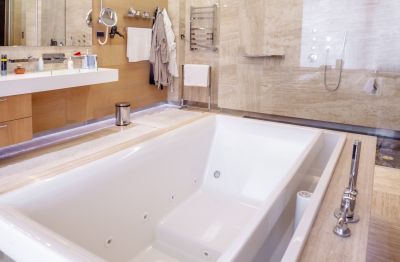Favorite Products For Bathtub Refinishings To Enhance Your Space
Choose from trusted supplies designed to deliver a smooth, durable finish and improve the overall look of your bathtub.
 Bathtub refinishing is a practical solution for revitalizing worn or outdated tubs, offering a fresh appearance without the need for full replacement. The process involves applying specialized coatings that adhere to the existing surface, creating a smooth, durable finish that can resemble new porcelain, acrylic, or fiberglass. This approach is often favored for its cost-effectiveness and minimal disruption to daily routines, making it a popular choice among homeowners looking to enhance their bathroom aesthetics.
Bathtub refinishing is a practical solution for revitalizing worn or outdated tubs, offering a fresh appearance without the need for full replacement. The process involves applying specialized coatings that adhere to the existing surface, creating a smooth, durable finish that can resemble new porcelain, acrylic, or fiberglass. This approach is often favored for its cost-effectiveness and minimal disruption to daily routines, making it a popular choice among homeowners looking to enhance their bathroom aesthetics.
Top Overall Option
Comprehensive Bathtub Refinishing Kit
A complete refinishing kit typically includes all necessary components such as primer, resurfacing paint, bonding agents, and sealers. These kits are designed to simplify the process for DIY enthusiasts and provide a cohesive set of products that work well together. They often feature detailed instructions to help users achieve a smooth, durable finish that can enhance the appearance of various bathtub surfaces. While not guaranteeing specific outcomes, a well-chosen kit can be a reliable starting point for those seeking to refresh their bathroom with minimal professional assistance.
Types of Products For Bathtub Refinishings
Epoxy Resurfacing Paint
Durable and resistant to moisture, epoxy paints are commonly used for refinishing tubs, providing a tough, glossy finish that withstands daily use.
Acrylic Coatings
Acrylic-based products offer flexibility and ease of application, often used for refinishing acrylic or fiberglass tubs with a smooth finish.
Polyurethane Sealers
Polyurethane sealers help protect the refinished surface from scratches, stains, and water damage, extending the lifespan of the finish.
Bonding Primers
Primers improve adhesion of the topcoat to existing surfaces, especially on porcelain or glazed finishes.
Etching Solutions
Used to prepare glazed surfaces by creating a rough texture, enhancing the bonding of refinishing products.
Resurfacing Kits
All-in-one kits that include primers, paints, and sealers designed specifically for bathtub refinishing projects.
Spray-on Refinishing Products
These products allow for quick application and a smooth finish, often used by professionals or experienced DIYers.
Brush-on Refinishing Paints
Ideal for detailed work or small areas, providing control during application.
Self-etching Primers
Primers that chemically etch the surface to improve bonding, especially on glazed or glossy finishes.
Anti-slip Coatings
Applied to the tub surface to add traction and reduce the risk of slipping.
Color Additives
Used to customize the finish with specific hues or to match bathroom decor.
Anti-mildew Sealers
Sealants that inhibit mold and mildew growth on the refinished surface.
Popular Choices
Popular for quick, even application, these kits are favored by DIYers for their convenience.
Offering a shiny, reflective finish, these paints are often chosen for their aesthetic appeal.
Known for their durability and chemical resistance, these coatings are frequently used in high-traffic bathrooms.
Designed for small chips and cracks, these kits help restore the surface before refinishing.
Popular for their ease of use and smooth finish, suitable for various bathtub materials.
Chosen for their ability to adhere to challenging surfaces like glazed porcelain.
Trusted for providing an additional layer of protection against moisture and stains.
Used to add slip-resistant textures to the bathtub surface.
Popular for achieving a seamless look that matches existing bathroom fixtures.
Favored in humid environments to prevent mold growth on refinished surfaces.
The selection of products for bathtub refinishing varies widely, encompassing primers, bonding agents, resurfacing paints, and sealers. Each component plays a crucial role in ensuring a long-lasting and visually appealing result. Proper surface preparation is essential, including cleaning, sanding, and sometimes etching, to promote adhesion. The application process typically involves multiple coats, with drying times carefully observed to achieve a uniform finish. When selecting products, it is important to consider compatibility with existing materials, ease of application, and the level of durability required.
While many products are designed for DIY use, professional-grade options often provide more resilient and high-quality finishes. Regardless of the choice, following manufacturer instructions diligently is key to achieving optimal results. Regular maintenance, such as gentle cleaning and avoiding abrasive scrubbers, can help preserve the refinished surface over time. Overall, investing in the right products and proper technique can significantly extend the lifespan of a bathtub and improve the overall look of a bathroom space.
Key Buying Considerations
- Compatibility with existing bathtub material such as porcelain, fiberglass, or acrylic.
- Ease of application, especially if undertaking a DIY project.
- Durability and resistance to water, stains, and scratches.
- Drying and curing times to plan the refinishing schedule accordingly.
- Level of gloss or matte finish desired to match bathroom decor.
- Compatibility of primers and sealers with the topcoat for optimal adhesion.
- Ease of cleaning and maintenance post-application.
- Availability of color options to match or complement bathroom fixtures.
- Resistance to mold and mildew in humid environments.
- Application method preferences, such as spray, brush, or roller.
- Product safety and ventilation requirements during application.
- Long-term performance and user reviews of the product.
- Cost considerations relative to project scope and quality.
- Shelf life and storage conditions of the refinishing products.
- Environmental factors like temperature and humidity during application.
